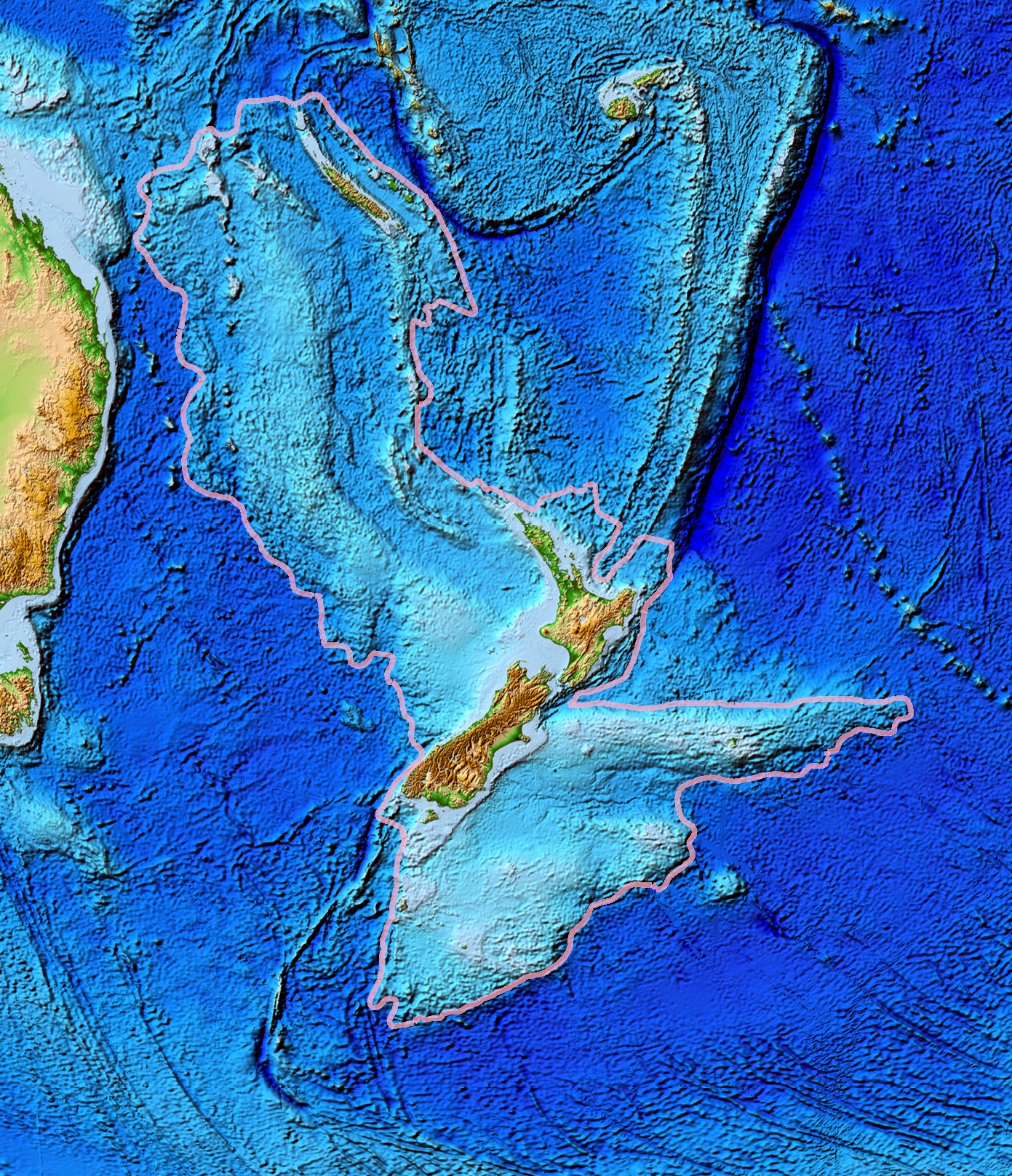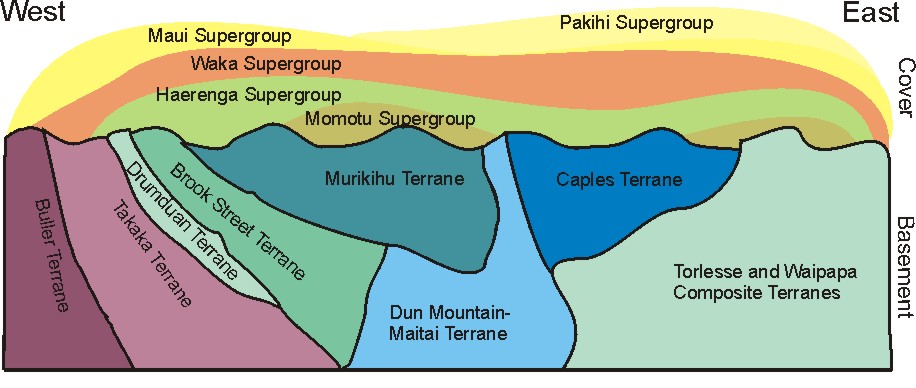|
Wanganui Basin
The Wanganui Basin (also spelled Whanganui Basin) is an onshore-offshore basin on the North Island of New Zealand. The basin provides an important stratigraphic and palaeontological record for the late Neogene marine environment of New Zealand. Location and setting The Wanganui Basin is located on the west coast of the North Island of New Zealand, within the Manawatū-Whanganui and Taranaki regions. The basin is roughly oval in shape, with the longer (approximately ) axis running west-south-west/east-north-east, and has a width of approximately . A little under half of the basin is onshore, extending inland around the lower reaches of the Whanganui and Rangitikei Rivers before terminating at the foot of the North Island Volcanic Plateau. The southern half of the basin extends into the South Taranaki Bight. The major population centre within the basin is along the coast, around the city of Whanganui. Geology Stratigraphy The Wanganui Basin is "one of the most complete late Neoge ... [...More Info...] [...Related Items...] OR: [Wikipedia] [Google] [Baidu] |
Mollusca
Mollusca is the second-largest phylum of invertebrate animals after the Arthropoda, the members of which are known as molluscs or mollusks (). Around 85,000 extant species of molluscs are recognized. The number of fossil species is estimated between 60,000 and 100,000 additional species. The proportion of undescribed species is very high. Many taxa remain poorly studied. Molluscs are the largest marine phylum, comprising about 23% of all the named marine organisms. Numerous molluscs also live in freshwater and terrestrial habitats. They are highly diverse, not just in size and anatomical structure, but also in behaviour and habitat. The phylum is typically divided into 7 or 8 taxonomic classes, of which two are entirely extinct. Cephalopod molluscs, such as squid, cuttlefish, and octopuses, are among the most neurologically advanced of all invertebrates—and either the giant squid or the colossal squid is the largest known invertebrate species. The g ... [...More Info...] [...Related Items...] OR: [Wikipedia] [Google] [Baidu] |
Zealandia
Zealandia (pronounced ), also known as ( Māori) or Tasmantis, is an almost entirely submerged mass of continental crust that subsided after breaking away from Gondwanaland 83–79 million years ago.Gurnis, M., Hall, C.E., and Lavier, L.L., 2004, Evolving force balance during incipient subduction: Geochemistry, Geophysics, Geosystems, v. 5, Q07001, https://doi.org/10.01029/02003GC000681 It has been described variously as a submerged continent, a continental fragment (or microcontinent), and a continent. The name and concept for Zealandia was proposed by Bruce Luyendyk in 1995, and satellite imagery shows it to be almost the size of Australia. A 2021 study suggests Zealandia is 1 billion years old, about twice as old as geologists previously thought. By approximately 23 million years ago the landmass may have been completely submerged. Today, most of the landmass (94%) remains submerged beneath the Pacific Ocean. New Zealand is the largest part of Zealandia that is above ... [...More Info...] [...Related Items...] OR: [Wikipedia] [Google] [Baidu] |
Stratigraphy Of New Zealand
This is a list of the units into which the rock succession of New Zealand is formally divided. As new geological relationships have been discovered new names have been proposed and others are made obsolete. Not all these changes have been universally adopted. This table is based on the 2014 New Zealand Stratigraphic Lexicon (Litho2014). However, obsolete names that are still in use and names postdating the lexicon are included if it aids in understanding. Names for particular rock units have two parts, a proper name which is almost always a geographic location where the rock is found and a hierarchical rank (e.g. Waitematā Group). This ranking system starts with individual 'beds' of rock which can be grouped into 'members', members are grouped into 'formations', formations into 'subgroups' then 'groups'. In New Zealand, groups are further combined into 'supergroups' or for basement rocks into terranes. Not all of these hierarchical layers are necessarily present within a ... [...More Info...] [...Related Items...] OR: [Wikipedia] [Google] [Baidu] |
Geology Of Taranaki
The Taranaki Region of New Zealand is built upon the Median Batholith in the West, and Greywacke Rocks in the East. However, no rocks older than Miocene times are visible at the surface. The dominant feature of the Taranaki Region is the andesitic stratovolcano of Mount Taranaki, which is only about 130,000 years old. The dissected hill country to the East of the Taranaki Peninsula, and West of the Central Volcanic Plateau ( Ruapehu and Tongariro) is composed of soft Miocene to Pleistocene sandstone and mudstone. The coastal lowlands around Wanganui to the South have well-developed Quaternary marine terraces, and coastal sand dunes. The Taranaki Basin is the only area in New Zealand with significant known oil and gas deposits, many of them offshore. Basement rocks Basement rocks do not outcrop in the Taranaki Region due to the thick sedimentary and volcanic cover. However, the basement rocks have been inferred through exploration drilling, geophysical surveys and extrapolation ... [...More Info...] [...Related Items...] OR: [Wikipedia] [Google] [Baidu] |
Amalda
''Amalda'' is a genus of medium-sized sea snails, a marine gastropod mollusc in the family Ancillariidae, the olives and allies.Bouchet, P. (2014). Amalda H. Adams & A. Adams, 1853. Accessed through: World Register of Marine Species at http://www.marinespecies.org/aphia.php?p=taxdetails&id=390993 on 2015-01-18 These snails usually live in the sand in fairly shallow water in tropical and temperate regions of the world. Most species are predators of marine bivalves. Species Species within the genus ''Amalda'' include: * ''Amalda abyssicola'' Schepman, 1911 * ''Amalda acuta'' Ninomiya, 1991 * † ''Amalda acutapex'' Raven & Recourt, 2018 * ''Amalda alabaster'' Kantor, Castelin, Fedosov & Bouchet, 2020 * ''Amalda albanyensis'' Ninomiya, 1987 * ''Amalda albocallosa'' (Lischke, 1873) * † ''Amalda allani'' (Olson, 1956) * ''Amalda allaryi'' Bozetti, 2007 * ''Amalda angustata'' (G.B. Sowerby II, 1859) * ''Amalda aureocallosa'' Shikama & Oishi, 1977 * ''Amalda aureomarginata'' K ... [...More Info...] [...Related Items...] OR: [Wikipedia] [Google] [Baidu] |
Alcithoe
''Alcithoe'' is a genus of large sea snails, marine gastropod molluscs in the family Volutidae, the volutes.Marshall, B. & Bail, P. (2015). "''Alcithoe'' H. Adams & A. Adams, 1853". In: MolluscaBase (2015). Accessed through: World Register of Marine Species at http://www.marinespecies.org/aphia.php?p=taxdetails&id=382339 on 2016-02-04 Description ''Alcithoe'' are large, benthic neogastropod marine snails. Powell, A. W. B., ''New Zealand Mollusca'', William Collins Publishers Ltd, Auckland, New Zealand 1979 Species are predators, and all taxa undergo direct development. Distribution ''Alcithoe'' species are found in seas surrounding New Zealand. There is a rich fossil record for the genus.Beu, A. G. & Maxwell, P. A. (1990). "Cenozoic Mollusca of New Zealand". ''New Zealand Geological Survey Bulletin''. 58. Species Species within the genus ''Alcithoe'' include: * '' Alcithoe aillaudorum''(Ph. Bouchet & G. T. Poppe, 1988) * '' Alcithoe albescens'' Bail & Limpus, 2005 * '' ... [...More Info...] [...Related Items...] OR: [Wikipedia] [Google] [Baidu] |
Penion
''Penion'' is a genus of large marine snails, commonly known as siphon whelks, classified within the mollusc family Austrosiphonidae, the true whelks.MolluscaBase eds. (2021). MolluscaBase. Penion P. Fischer, 1884. Accessed through: World Register of Marine Species at: http://www.marinespecies.org/aphia.php?p=taxdetails&id=488452 on 2021-12-24 Description Siphon whelks are large, benthic marine snails, or whelks. Powell A. W. B., ''New Zealand Mollusca'', William Collins Publishers Ltd, Auckland, New Zealand 1979 Willan, R.C., de C. Cook, S., Spencer, H.G., Creese, R.G., O’Shea, S., Jackson, G.D. Phylum Mollusca. In: de C. Cook, S.C. (eds.), ''New Zealand Coastal Marine Invertebrates 1'', 406 – 407. Canterbury University Press, Christchurch, New Zealand ''Penion'' are commonly called siphon whelks because they have a very long siphon. Species typically have a large, pointed operculum. Ponder, W.F. 1973. A review of the Australian species of ''Penion'' Fischer (Neogastr ... [...More Info...] [...Related Items...] OR: [Wikipedia] [Google] [Baidu] |
Buccinulum
''Buccinulum'' is a genus of sea snails, marine gastropod molluscs in the family Buccinidae, the true whelks.MolluscaBase eds. (2020). MolluscaBase. Buccinulum Deshayes, 1830. Accessed through: World Register of Marine Species at: http://www.marinespecies.org/aphia.php?p=taxdetails&id=137700 on 2020-06-20 Description ''Buccinulum'' are small to medium-sized marine snails.Willan, R.C., de C. Cook, S., Spencer, H.G., Creese, R.G., O’Shea, S., Jackson, G.D. Phylum Mollusca. In: de C. Cook, S.C. (eds.), ''New Zealand Coastal Marine Invertebrates 1'', 396 – 401. Canterbury University Press, Christchurch, New Zealand Species vary significantly in shell sculpture and colouration and can be difficult to distinguish from one another. Distribution The majority of extant and fossil species are from New Zealand. Powell A. W. B., ''New Zealand Mollusca'', William Collins Publishers Ltd, Auckland, New Zealand 1979 Most species are commonly abundant within the intertidal and shallow ... [...More Info...] [...Related Items...] OR: [Wikipedia] [Google] [Baidu] |
Aeneator (gastropod)
''Aeneator'' is a genus of sea snails, marine gastropod molluscs in the family Buccinidae, the true whelks. Description ''Aeneator'' is a genus of small to medium sized marine snails. Powell A. W. B., ''New Zealand Mollusca'', William Collins Publishers Ltd, Auckland, New Zealand 1979 Large shells and fossils of ''Aeneator'' can sometimes be confused with those of '' Penion''. Distribution Most extant species of ''Aeneator'' are found around New Zealand, Chile, and Antarctica. Stilwell, J.D., Zinsmeister, W.J. 1992. Molluscan systematics and biostratigraphy, lower Tertiary La Meseta Formation, Seymour I ... [...More Info...] [...Related Items...] OR: [Wikipedia] [Google] [Baidu] |
Murex
''Murex'' is a genus of medium to large sized predatory tropical sea snails. These are carnivorous marine gastropod molluscs in the family Muricidae, commonly called "murexes" or "rock snails".Houart, R.; Gofas, S. (2010). Murex Linnaeus, 1758. In: Bouchet, P.; Gofas, S.; Rosenberg, G. (2010) World Marine Mollusca database. Accessed through: World Register of Marine Species at http://www.marinespecies.org/aphia.php?p=taxdetails&id=138196 on 2011-04-09 The common name murex is still used for many species in the family Muricidae which were originally given the Latin generic name ''Murex'' in the past, but have more recently been regrouped into different newer genera. The word ''murex'' was used by Aristotle in reference to these kinds of snails, thus making it one of the oldest classical seashell names still in use by the scientific community. Fossil records This genus is known in the fossil records from the Cretaceous to the Quaternary (age range: from 125.45 to 0.0 millio ... [...More Info...] [...Related Items...] OR: [Wikipedia] [Google] [Baidu] |
Zethalia
''Zethalia'' is a genus of sea snails in the subfamily Umboniinae of the family Trochidae The Trochidae, common name top-snails or top-shells, are a family of various sized sea snails, marine gastropod molluscs in the subclass Vetigastropoda. This family is commonly known as the top-snails because in many species the shell resembles ..., the top snails, first formally named in 1918. Species There is one extant (still living) species and two extinct species within the genus ''Zethalia'': * †''Zethalia coronata'' Marwick, 1948 * †''Zethalia russelli'' Marwick, 1965 * '' Zethalia zelandica'' (Hombron & Jacquinot, 1855) References * Trew, A., 1984. ''The Melvill-Tomlin Collection. Part 30. Trochacea''. Handlists of the Molluscan Collections in the Department of Zoology, National Museum of Wales. * Vaught, K. C. (1989). ''A classification of the living Mollusca''. Melbourne, Florida : American Malacologists. xii + 189 pp. * {{Trochidae-stub ... [...More Info...] [...Related Items...] OR: [Wikipedia] [Google] [Baidu] |





.jpg)
